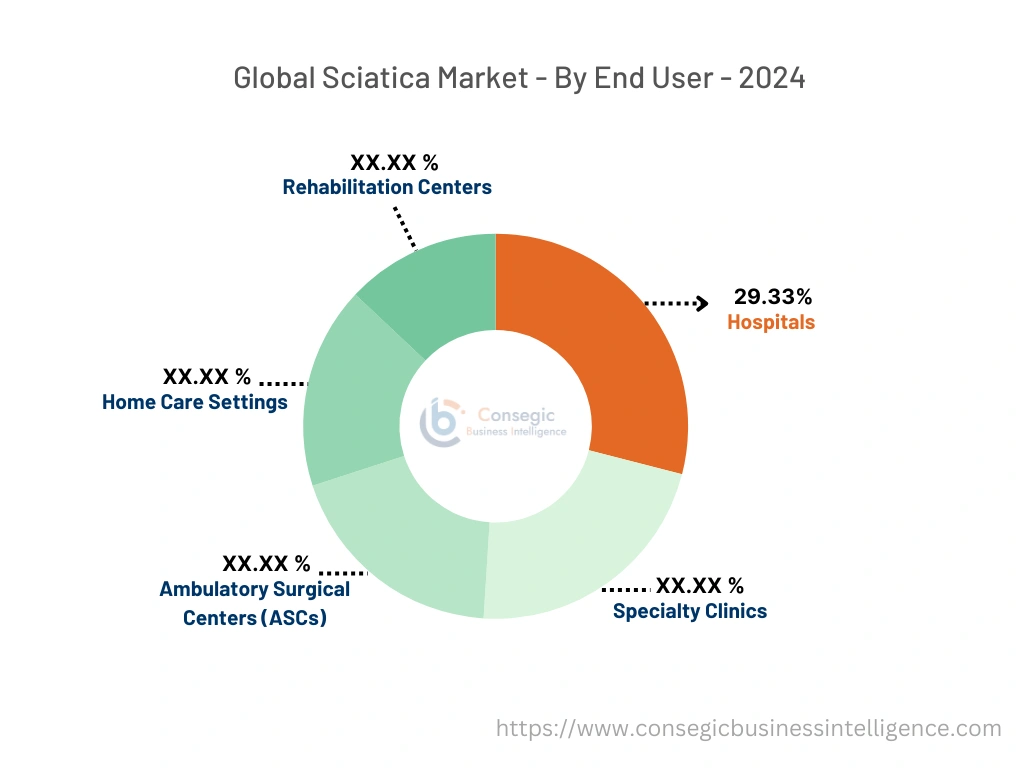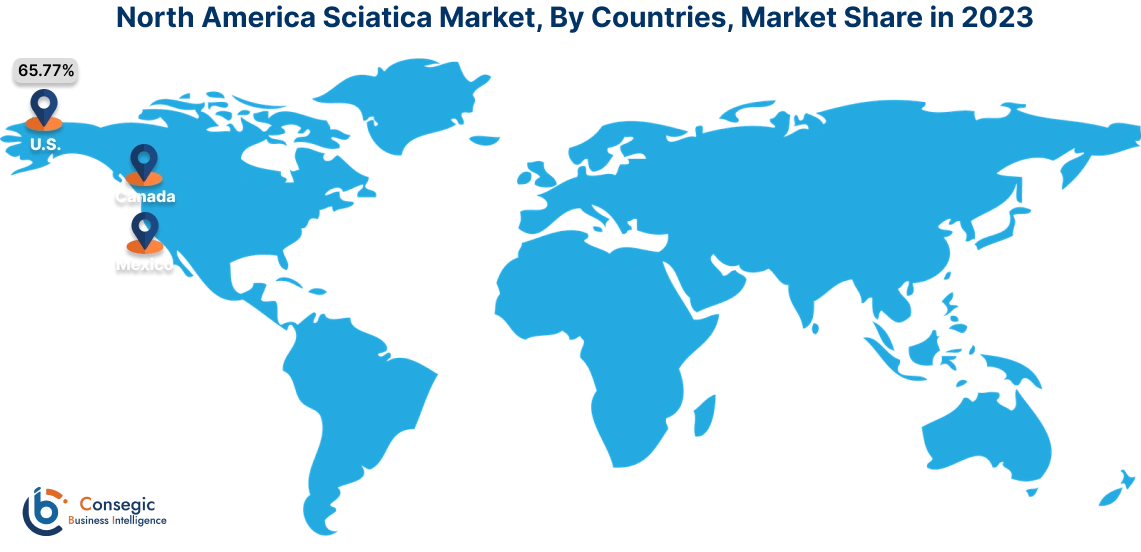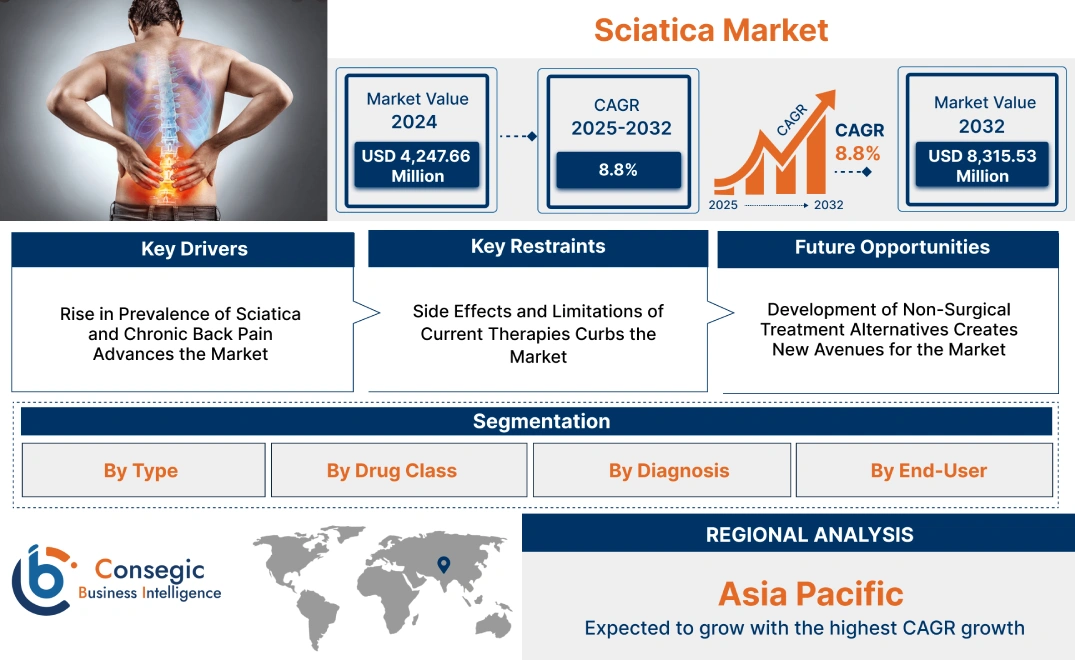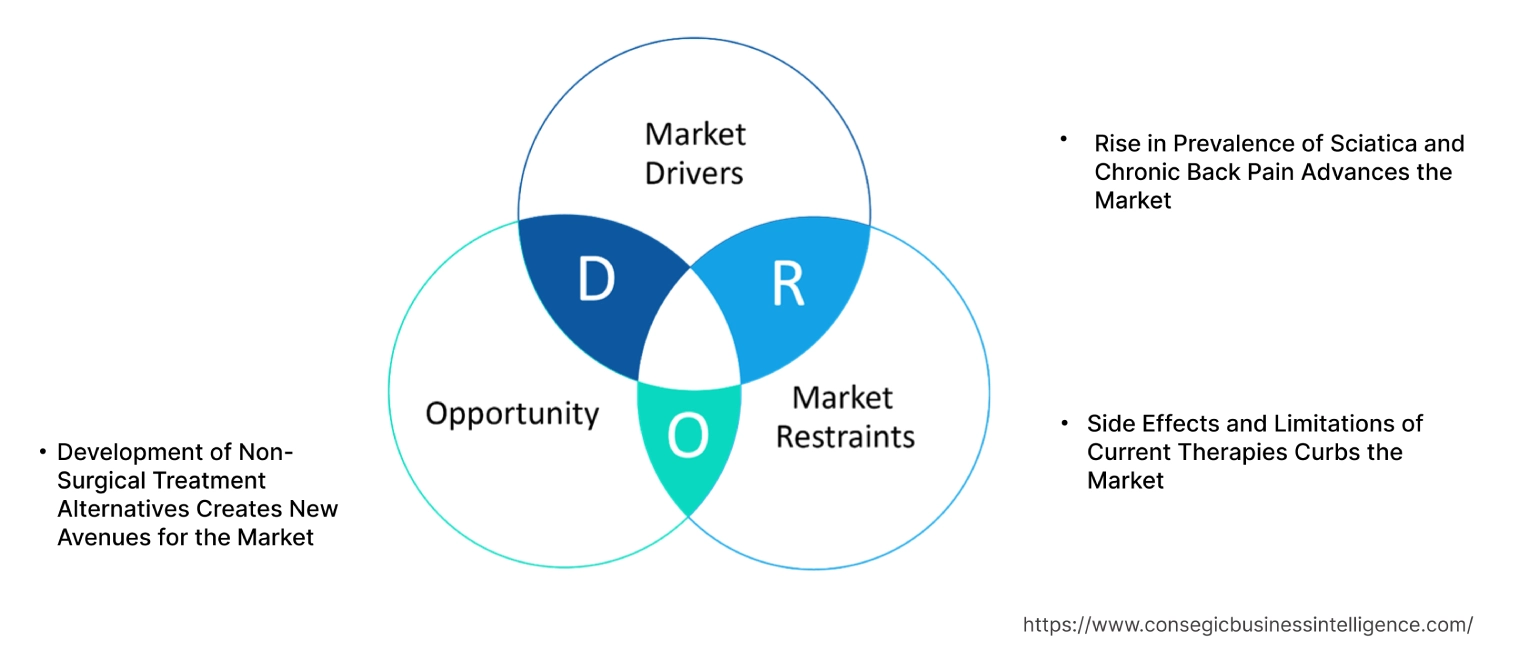- Summary
- Table Of Content
- Methodology
Sciatica Market Size:
Sciatica Market size is estimated to reach over USD 8,315.53 Million by 2032 from a value of USD 4,247.66 Million in 2024, growing at a CAGR of 8.8% from 2025 to 2032.
Sciatica Market Scope & Overview:
Sciatica refers to a situation that is characterized by a wave of pain that radiates along the path of the sciatic nerve. The nerve, being the longest and the thickest nerve in our body, runs from the lower back, through the hips, buttocks, and down to each leg. It often affects only one side of our body. It is not a mortally fatal predicament in itself but arises as a symptom of chronic nerve problems such as herniated discs, degenerative disc disease, spinal stenosis, spondylolisthesis, trauma injury, etc. The degree of pain varies from mild to severe and it begins as a numbness or tingling sensation which cascades down to the sciatic nerves in the legs. It is responsible for muscle weakness and difficulty in standing or walking due to extreme pain. The diagnosis involves physical examination, imaging tests, nerve tests, etc. It can be cured through non-surgical treatments through medicines (painkillers, antidepressants, steroid injections), therapies (physical therapy, chiropractic care, massage therapy), lifestyle modifications, etc. In case of need, it also has surgical treatments such as microdiscectomy, spinal infusion, laminectomy, etc.
Sciatica Market Insights:
Key Drivers:
Rise in Prevalence of Sciatica and Chronic Back Pain Advances the Market
Globally, a high percentage of people are suffering from ailments such as degenerative spinal conditions, chronic back pain (lower back pain LBP), herniated discs, etc. This is due to factors such as prolonged sedentary lifestyles, improper posture, lack of physical activities, etc. It gives rise to this disease, which arises as a result of pain experienced at the sciatic nerve endings. Patients are increasingly made aware of the benefits of seeking out treatments for pain leading to development and innovation in tools and therapies as pain management solutions. This often includes imaging tests, chiropractic lessons, yoga, etc., which are minimally invasive, and thus, attractive to patients.
- In June 2023, the World Health Organization (WHO) released an article highlighting the global insurgence of lower back pain (LBP). They discussed how Lower Back Pain has affected around 619 million people globally since 2020 and is a primary cause of disability. LBP can affect individuals from any age group but specifically materializes among individuals of around 50-55 years. Amongst the two types of LBP (specific and non-specific) women are likely to experience non-specific LBP in a larger proportion than men.
Therefore, as the condition of LBP rises, pharmaceutical companies offer a varied range of treatments and medications to relieve pain, driving the sciatica market demand.
Key Restraints :
Side Effects and Limitations of Current Therapies Curbs the Market
Primary treatments for sciatica like nonsteroidal anti-inflammatory drugs (NSAIDs), opioids, muscle relaxants, etc. have side effects such as drowsiness, gastrointestinal pain, addiction risks, and other varied complications. The long-term dependence on these medications often affects the patient's overall health. Relatively, healthcare workers tend to advise the provision of physical treatments, chiropractic care, etc. However, these methods have limited long-lasting effects on severe cases, such as advanced spinal degeneration or herniated discs. Meanwhile, surgical treatments such as spinal fusion carry risks of infection, spinal instability, or nerve damage. The current treatment options are expensive and also leave the avenue open for the recurrence of the condition.
- In May 2023, long run. According to the analysis of Sydney Musculoskeletal Health, surgery is an efficient way to alleviate leg pain and disability in certain instances. Though the benefits last only for 12 months, post-surgery.
Therefore, as per the market trends analysis, the long-term efficacy of available therapies leaves patients dissatisfied, and this curbs the overall sciatica market expansion.
Future Opportunities :
Development of Non-Surgical Treatment Alternatives Creates New Avenues for the Market
The rise of non-surgical methods such as epidural steroid injections, radiofrequency ablation, nerve block injections, etc. has successfully provided pain relief to patients suffering from sciatica without surgery. Such non-surgical treatments offer to address the root cause of the acute pain resulting in minimal side effects and reduction in recovery periods. There are also personalized physical therapy programs that often prioritize building up muscle strength and spine posture leading to better flexibility. It helps in targeting bad posture, which is a leading cause of sciatic pain among the young demographic. Innovative technologies such as transcutaneous electrical nerve stimulation (TENS) devices, spinal cord stimulators, etc. provide pain management by opposing the pain signals sent to the brain. There is also the insurgence of regenerative medicines such as platelet-rich plasma (PRP) for reduction in inflammation and rebuilding of damaged tissues, promoting natural (self-healing) in sciatica cases.
- In 2023, long term. The integration of artificial intelligence (AI) with self-healing offers a non-surgical variation to patients. This research was funded by Sanofi, a leading biopharmaceutical company, and combines infrared technology with the concepts of self-healing and wearable patches.
Therefore, as non-surgical methods present a cost-effective and high-patient satisfaction alternative to existing treatments, they establish new sciatica market opportunities.
Sciatica Market Segmental Analysis :
By Type:
The market is bifurcated based on type into Acute Sciatica and Chronic Sciatica.
Trends in the Type:
- Recently, the integration of a novel drug delivery system for managing acute sciatica is experiencing a heightened market demand.
- A major trend in the market is the utilization of Pulsed Radiofrequency (PRF), a new innovative minimally invasive treatment, for managing sciatic pain without surgery.
Chronic Sciatica accounted for the largest revenue in the sciatica market share in 2024.
- Chronic sciatica is prevalent among the geriatric demographic as with age, the risk of developing degenerative spinal diseases such as spinal stenosis increases.
- Chronic sciatica, unlike acute sciatica necessitates prolonged intensive treatment to provide patients with continuous pain management through physical therapies and often surgeries.
- This type of sciatic pain requires a comprehensive range of treatments such as diagnostic imaging, regenerative medications, follow-up care, etc.
- Thus, as per sciatica market analysis, chronic sciatica generates the largest revenue due to growing awareness of pain management solutions and a demand for effective treatment.
Acute Sciatica is expected to have the fastest-growing CAGR during the forecasted period.
- Acute sciatica which manifests as lower back pain (LBP) below the knee is a direct result of a modern sedentary lifestyle, improper posture, etc. This leads to muscle strains which results in sciatic pain.
- The growth of awareness among patients and healthcare professionals about the transgressions of acute sciatic pain into chronic pain if left untreated for a long period. This has resulted in more early diagnosis focused on pain alleviation.
- Acute sciatica management is cost-effective, unlike chronic sciatica, since this type of pain can be cured through non-surgical methods of physical therapy, chiropractic care, etc.
- Therefore, as innovative rehabilitation tools are introduced into the market for pain management, acute sciatica will experience faster growth in the future.
By Drug Class:
The market is segmented based on drug class into Nonsteroidal Anti-Inflammatory Drugs (NSAIDs), Muscle Relaxants, Steroids (Corticosteroids), Opioids, Antidepressants, Anticonvulsants, and others.
Trends in the Drug Class:
- Cyclobenzaprine is a recent novel muscle relaxant that offers pain relief by blocking nerve impulses to the brain.
- Recently, Clonidine emerged as a new drug that is administered to patients as a small pellet into the epidural space in the lumbar section of the back.
Nonsteroidal Anti-Inflammatory Drugs (NSAIDs) accounted for the largest revenue in the sciatica market in 2024.
- Nonsteroidal anti-inflammatory drugs (NSAIDs) are primarily the first line of treatment which are prescribed as over-the-counter medication for managing sciatic pain.
- Patients rely on the effective way NSAIDs, such as aspirin, ibuprofen, naproxen, etc. offer speedy relief from sciatic pain by reducing the inflammatory pain around the sciatic nerve.
- They are cost-effective and hence affordable to patients, unlike alternative treatments such as muscle relaxants, surgeries, opioids, etc. They are viable for prolonged use, which is essential for patients with chronic sciatica.
- NSAIDs have a strong global distribution system and have proper permits that adhere to the rules and regulations of most nations.
- For instance, Dover Addaprin is a type of ibuprofen (NSAID) that effectively minimizes minor pain caused by menstrual cramps, muscle pains, backaches, etc.
- Thus, as per the analysis, the growth of sciatica among the global population, and NSAIDs contribute to the largest revenue generation within the market.
Anticonvulsants are expected to have the fastest-growing CAGR during the forecasted period.
- Anticonvulsants such as pregabalin or gabapentin are proficient in treating neuropathic pain by stabilizing nerve activity and reducing pain signals in sciatic patients.
- Unlike opioids, anticonvulsants do not induce addiction when incorporated as a remedy for long-term acute sciatica treatment.
- They are most effective when used in combination with physical therapy or NSAIDs as a pain management solution.
- For instance, Cannabidiol is an effective, FDA-approved anticonvulsant drug that offers pain relief from seizures and also reduces the frequency of seizures among patients with LSG or Dravet syndrome.
- Therefore, as anticonvulsants are firmly integrated into the medical system for their effective targeted therapy, this segment will drive the sciatica market trends.
By Diagnosis:
The market is segmented based on diagnosis into Physical Exam and Imaging Tests (MRI, CT scan, X-rays) and Electromyography (EMG).
Trends in the Diagnosis:
- Recently, biomarker analysis has emerged as an effective diagnostic method for sciatic pain as it can easily predict the severity of the pain.
- Machine learning and AI algorithms (CT-PRF) are improving diagnostic accuracy and providing personalized predictive treatment for sciatic pain.
MRI accounted for the largest revenue in the overall sciatica market share in 2024.
- MRIs unlike CT scans or X-rays provide detailed images of soft tissues, including spinal discs, muscles, nerves, etc. making it an efficient method to root out the exact location of sciatic pain.
- Patients with chronic or recurring sciatica rely on MRIs for accurate imaging for their long-term treatment journey to detect changes in the spine or nerve compression.
- Innovations in biotechnology have led to the development of more efficient MRI machines that have enhanced image resolution, and quick scanning. This results in increased accuracy of imaging tests in diagnosing sciatica.
- This type of non-invasive imaging test, unlike CT scan or X-rays, does not involve the use of radiation, making it safe and attractive for the patients.
- For instance, Mayo Clinic offers high-tech MRI scans to their patients. Their machine can offer 3D images which can be studied from various angles.
- Thus, as the demand for precise imaging in diagnosing sciatic pain increases, this segment drives the sciatica market growth.
Electromyography (EMG) is expected to have the fastest-growing CAGR during the forecasted period.
- Electromyography (EMG), is known to measure muscle response or electrical activity as a riposte to a nerve's stimulation of the muscle. This helps in differentiating between nerve compression and various other factors behind muscle pain and accurately determining the cause of sciatic pain.
- Biotechnological advancements have made EMG devices portable, making them easy to use, without compromising the accuracy of the test and the patient's physical comfort.
- As EMG provides precise nerve and muscle analysis, it is beneficial in integrated multidisciplinary treatment strategies for rehabilitation processes.
- EMG is an efficient and safe alternative for patients who cannot incorporate pacemakers due to allergies to contrast dyes.
- For instance, John Hopkins Medicine offers electromyography (EMG) tests to their patients as a part of their neurological treatment.
- Therefore, as there is an insurgence of neuromuscular testing, EMG would experience the fastest growth in this segment boosting the sciatica market trends.
By End-User:
The market is segmented based on end-users into Hospitals, Specialty Clinics, Ambulatory Surgical Centers (ASCs), Home Care Settings, and Rehabilitation Centers.
Trends in the End-User:
- Recently, most specialty clinics, ambulatory surgical centers (ASCs), etc., are offering regenerative medicines such as stem cell treatments to repair frayed nerves.
- Rehabilitation centers recently are incorporating wearable technology to detect pain levels, posture, and movement in patients to provide accurate feedback.
Hospitals accounted for the largest revenue share of 29.33% in 2024.
- Hospitals often provide comprehensive treatment facilities such as pain management therapies, advanced imaging tests, physical therapy along surgical interventions. This gives the patient a convenient treatment strategy for curing sciatic pain.
- Hospitals have a high patient volume as they are reliable avenues for sciatic treatment. This is due to the availability of advanced technologies such as high-tech MRI machines and innovative surgical equipment within the hospitals.
- They offer emergency care and inpatient treatments for patients who have chronic or recurring sciatic pain.
- Hospitals have a multidisciplinary approach as they employ an expert team of oncologists, orthopedic surgeons, neurosurgeons, physical therapists, and other skilled personnel for pain management.
- For instance, New York Presbyterian offers sciatic pain treatment which includes diagnostic testing and non-invasive treatment procedures.
- Thus, as the treatment charges are well-covered by insurance, patients approach hospitals for an efficient treatment procedure, this segment drives the sciatica market demand.
Specialty Clinics are expected to have the fastest-growing CAGR during the forecasted period.
- Specialty clinics are effectively dedicated to particular areas such as neurology or orthopedics etc. This results in offering high-quality and expert diagnoses tailored to specific types of sciatic pain.
- They offer minimally invasive treatment processes such as regenerative therapies, which most patients seek, as they search for the latest and innovative treatments.
- They have a patient-centric approach which allows them to curate tailored programs that have longer consultation timings. This enhances treatment outcomes and patient satisfaction.
- The expansion of telemedicine which specialty clinic offers widens the reach of sciatic treatments to remote areas fostering the growth of such clinics.
- For instance, Keck Medicine of USC is a medical arm of the University of Southern California that offers specialized treatment for various conditions, including sciatic pain.
- Thus, as patient preference shifts from inpatient care to outpatient care, specialty clinics will boost the sciatica market opportunities.

Regional Analysis:
The regions covered are North America, Europe, Asia Pacific, the Middle East and Africa, and Latin America.

In 2024, North America accounted for the highest market share at 37.23% and was valued at USD 1,408.98 Million, and is expected to reach USD 2,695.06 Million in 2032. In North America, the U.S. accounted for the highest market share of 65.77% during the base year of 2024. In North America, particularly in the U.S., there is a highly developed medical infrastructure for the healthcare systems which facilitates the growth of a robust market due to proficient research and development (R&D). The healthcare department offers expert diagnostics, surgeries, and treatments for alleviating pain. There is also a dynamic pharmaceutical base in North America which results in better medication for minimally invasive methods.
Asia Pacific is expected to witness the fastest CAGR over the forecast period of 9.20% during 2025-2032. Asia Pacific (APAC) especially in nations like Japan, China, India, and South Korea there is a rapidly growing aging demographic. This aging population is prone to experiencing pain due to degenerative conditions, chronic ailments, issues, etc. These countries also have a sedentary lifestyle that contributes to spondylolisthesis, a good marker of pain.
- For instance, Asian Spine Hospital offers spinal fixations and spinal trauma surgeries for sciatica patients, especially for the aging demographic experiencing pain from chronic diseases.

Europe has a large concentration of obesity cases which often leads to back pain, spinal stenosis, etc. Sciatica pain is common for people with people suffering from obesity as excess weight puts pressure on the spine. This has led to a growth in awareness of solutions, leading to the expansion of the market in this region.
The Middle East and Africa (MEA) region, especially the Gulf region like UAE, Saudi Arabia, etc. have an accumulation of people with disposable income. This allows the population to invest in improved and better treatment for their sciatic pain, driving sciatica market expansion.
In Latin America, particularly in regions like Mexico, Brazil, Argentina, etc. chiropractic and physical therapy are popular. There is a widespread cultural preference for such non-surgical treatments which are often associated with alleviating sciatic pain.
Top Key Players & Market Share Insights:
The sciatica market is highly competitive with major players providing precise measurement between objects to the national and international markets. Key players are adopting several strategies in research and development (R&D), product innovation, and end-user launches to hold a strong position in the global sciatica market. Key players in the sciatica industry include-
- Pfizer Inc. (USA)
- Novartis AG (Switzerland)
- Johnson & Johnson Services, Inc. (USA)
- GSK plc. (UK)
- Merck & Co., Inc. (USA)
- Teva Pharmaceutical Industries Ltd. (Israel)
- Sanofi (France)
- Bayer AG (Germany)
- Lilly (USA)
- Abbott (USA)
Recent Industry Developments :
Product Launches:
- In July 2024, Rolflex Recovery announced the launching of a new foam rolling solution for Sciatica pain relief. The product aims to offer users to put accurate pressure on the aching areas resulting in the reduction of inflammation and easier blood flow. This would alleviate the pain caused by sciatica. The roller is engineered from state-of-the-art materials to ensure constancy in recovery regimen.
Mergers & Acquisitions:
- In September 2024, Semnur Pharmaceuticals announced its merger with Denali Capital Acquisition Corp. in an agreement worth $2.5 billion. Semnur Pharmaceuticals is a subsidiary of Scilex Holding Company and offers new non-opioid pain therapies as a clinical late-stage pharma company. Denali Capital is a blank check firm. Following this merger with the special acquisition company, Semnur would go public as Semnur Pharmaceuticals, Inc. Its integrated stock and warrants would be listed as ‘SMNR' and ‘SMNRW' respectively. It is aimed to give the companies an alternative to list their shares and gain acclimation.
Sciatica Market Report Insights :
| Report Attributes | Report Details |
| Study Timeline | 2019-2032 |
| Market Size in 2032 | USD 8,315.53 Million |
| CAGR (2025-2032) | 8.8% |
| By Type |
|
| By Drug Class |
|
| By Diagnosis |
|
| By Application |
|
| By End-User |
|
| By Region |
|
| Key Players |
|
| North America | U.S. Canada Mexico |
| Europe | U.K. Germany France Spain Italy Russia Benelux Rest of Europe |
| APAC | China South Korea Japan India Australia ASEAN Rest of Asia-Pacific |
| Middle East and Africa | GCC Turkey South Africa Rest of MEA |
| LATAM | Brazil Argentina Chile Rest of LATAM |
| Report Coverage |
|
Key Questions Answered in the Report
Who are the major players in the sciatica market? +
The major players in the market include Pfizer Inc. (USA), Novartis AG (Switzerland), Johnson & Johnson Services, Inc. (USA), Teva Pharmaceutical Industries Ltd. (Israel), Sanofi (France), GSK plc. (UK), Merck & Co., Inc. (USA), Bayer AG (Germany), Lilly (USA), and Abbott (USA).
Which region will lead the sciatica market? +
North America will lead the global sciatica market in the future.
What specific segmentation details are covered in the sciatica market report? +
The sciatica market is segmented into type, drug class, diagnosis, and end-user industry.
Which is the fastest-growing region in the sciatica market? +
Asia Pacific is the fastest-growing region in the sciatica market.


